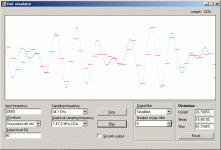Hello!
Some time ago I made some considerations about filters and I found the following filter interesting:
A subharmonic series of cosine bursts with alternating sign:
sum(-(-1)^i/i cosburst(x/i),(i,1,infinity))
cosburst(x):=cos(x)+1 for (x,-pi,pi), else 0.
would give an infinite impulse response that could be clipped, preferably at zeros.
The response is not strictly periodical, the distance between the zeros increases towards the periphery.
The frequency domain of the stopband is aperiodical.
My questions: Is this new, and would this behaviour be an advantage compared to conventional filters?
Regards, Oliver
Some time ago I made some considerations about filters and I found the following filter interesting:
A subharmonic series of cosine bursts with alternating sign:
sum(-(-1)^i/i cosburst(x/i),(i,1,infinity))
cosburst(x):=cos(x)+1 for (x,-pi,pi), else 0.
would give an infinite impulse response that could be clipped, preferably at zeros.
The response is not strictly periodical, the distance between the zeros increases towards the periphery.
The frequency domain of the stopband is aperiodical.
My questions: Is this new, and would this behaviour be an advantage compared to conventional filters?
Regards, Oliver
Hi Olivier,
Are you able to give simple math formula of your filter like
Y =K1 * S1 + K2 * S2...
where Kx are constant coefficient and Sn, previous and next input sample.
I could insert this filter in my DAC Simulator to have response to your question.
Eric
Are you able to give simple math formula of your filter like
Y =K1 * S1 + K2 * S2...
where Kx are constant coefficient and Sn, previous and next input sample.
I could insert this filter in my DAC Simulator to have response to your question.
Eric
Attachments
Hello Eric!
I converted the (finite) impulse response into numerical form using Mathematica and used the numerical integral to calculate the frequency response. So I already know the filter has this aperiodical behaviour. What I am asking myself is: Does this have a sonical benefit in terms of less audible filter ringing?
But if your simulator has some useful features I can`t easyly implement in Mathematica I can calculate the filter coefficients.
I converted the (finite) impulse response into numerical form using Mathematica and used the numerical integral to calculate the frequency response. So I already know the filter has this aperiodical behaviour. What I am asking myself is: Does this have a sonical benefit in terms of less audible filter ringing?
But if your simulator has some useful features I can`t easyly implement in Mathematica I can calculate the filter coefficients.
Or is it more desirable to have zeros at multiples of the Nyquist frequency in order to get least possible aliasing at low frequencies?
Hello Oliver,
The simulator is written in C#, (µsoft .NET 2005) it is not and ended project, I add function to have wide comprehension of digital audio. If you are interested in, we could share this project. Final version will be free to download.
Eric
With the simulator, you could see real output samples. Testing digital filter with various, non cyclic, input waveform is very interesting. Instant distortion is often greater the theory.el`Ol said:...But if your simulator has some useful features I can`t easyly implement in Mathematica I can calculate the filter coefficients.
The simulator is written in C#, (µsoft .NET 2005) it is not and ended project, I add function to have wide comprehension of digital audio. If you are interested in, we could share this project. Final version will be free to download.
Eric
On the actual DAC simulator, I implement a simplified digital filter like you could find in Wadia and of course standard Sin(x)/x filter.
I will mail you the coefficients. How much oversampling? 8x? 16x?
Center on a sample or between two samples?
Center on a sample or between two samples?
Hi Olivier,
Eric
2x oversampling between two samples. I think, like over filters, to obtain 8x ovsl you cascade filters.el`Ol said:I will mail you the coefficients. How much oversampling? 8x? 16x?
Center on a sample or between two samples?
Eric
Hello Eric!
About the cascading: Doesn`t become the impulse response very long if I do this?
And there is an other reason why my filter is not very suitable for low oversampling: The originally infinite response is clipped at zeros that are completely out of phase with the resulting (ADC) respectively original (DAC) sample rate, so a fine resolution should be better.
If your simulator can handle high oversampling I could give you the coefficients with center on a sample (odd number of coefficients to be time-symmetrical) or between two samples (even number of coefficients to be time symmetrical). I could give you a high number of coefficients if you like, so you could try different zeros for clipping.
An OT question: Are there ADCs that work with elliptic 120dB filters or do all work with phase-correct FIR filters?
Greets,
Oliver
About the cascading: Doesn`t become the impulse response very long if I do this?
And there is an other reason why my filter is not very suitable for low oversampling: The originally infinite response is clipped at zeros that are completely out of phase with the resulting (ADC) respectively original (DAC) sample rate, so a fine resolution should be better.
If your simulator can handle high oversampling I could give you the coefficients with center on a sample (odd number of coefficients to be time-symmetrical) or between two samples (even number of coefficients to be time symmetrical). I could give you a high number of coefficients if you like, so you could try different zeros for clipping.
An OT question: Are there ADCs that work with elliptic 120dB filters or do all work with phase-correct FIR filters?
Greets,
Oliver
Direct upload was not possible (for whatever reason), so here via ImageShack:
http://img221.imageshack.us/img221/5020/cosburstyq6.jpg
http://img221.imageshack.us/img221/5020/cosburstyq6.jpg
- Status
- Not open for further replies.
- Home
- Source & Line
- Digital Source
- new filter?
